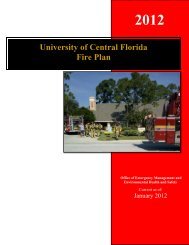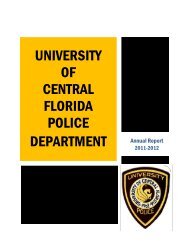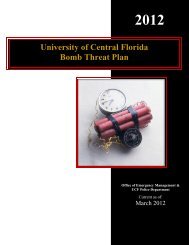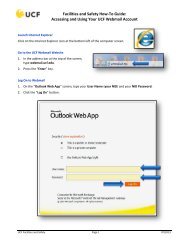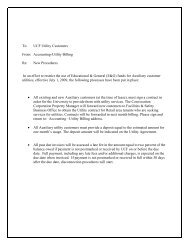University of Central Florida Severe Weather Plan - UCF Facilities ...
University of Central Florida Severe Weather Plan - UCF Facilities ...
University of Central Florida Severe Weather Plan - UCF Facilities ...
You also want an ePaper? Increase the reach of your titles
YUMPU automatically turns print PDFs into web optimized ePapers that Google loves.
<strong>UCF</strong> <strong>Severe</strong> <strong>Weather</strong> <strong>Plan</strong> 2012CHAPTER 3: THUNDERSTORMS3.1. General Thunderstorm Information3.1.1. Thunderstorms may develop at any time <strong>of</strong> the year. Although thunderstorms occur mostfrequently during the summer months, the more violent storms occur in the winter andearly spring. The Orlando area experiences thunderstorms approximately 90 days out <strong>of</strong>every year.3.1.2. Thunderstorms can be single cell, multicell cluster, multicell line, and super cell.Supercells usually form severe thunderstorms. Thunderstorms typically consist <strong>of</strong> veryhigh winds, rain, lightning, and in many cases, hail. Typically, the larger the hail is, thestronger the thunderstorm is. Hail 1” in diameter or more with winds in excess <strong>of</strong> 58 mphindicate a severe thunderstorm where tornadoes are also possible.3.1.3. Every year, central <strong>Florida</strong> experiences approximately 90 days with thunderstorms. <strong>Plan</strong>in advance.3.1.3.1. All persons are advised to monitor the weather daily during the summerthunderstorm season and to plan their work around any threatening weatherconditions. <strong>Severe</strong> weather information can be obtained via local radio stationsor the Internet. The <strong>University</strong> has placed NOAA weather radios throughout thecampus to help with monitoring local severe weather.3.1.3.2. All supervisors should be aware <strong>of</strong> their responsibility to advise any employeesor students vulnerable to thunderstorms. Vulnerability to thunderstormsincludes, but is not limited to, persons outside and persons in portable trailers.Such persons should be warned to take cover when storms approach.3.1.3.3. Instructors and supervisors in portable trailers or modular facilities should beaware such facilities might not be safe in high winds. All persons in portablesshould learn which permanent (brick or block) facilities are nearest to theirportable, and should plan an escape route to the permanent facility.3.2. Lightning3.2.1. The most dangerous aspect <strong>of</strong> a thunderstorm is lightning. The best protection fromlightning is to seek shelter in a nearby building.3.2.2. Cloud-to-ground lightning density in this area is approximately 28 strikes per square mileper year, meaning lightning could possibly hit around the <strong>UCF</strong> main campusapproximately 50 times each year.3.2.3. When thunderstorms threaten, seek shelter in a fully enclosed building or car. Avoidwater, metal objects, and open spaces. Note that golf carts, trees, tents and boats areunsafe places.Page 14




